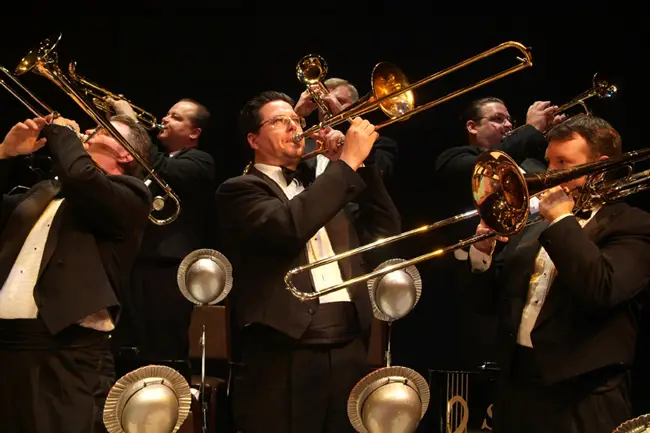
Maybe it shouldn’t boggle the mind that one of the most dour periods in recent history—the 1940s, when the world was at war for half the decade and struggling to recover the other half—produced some of the most upbeat music of the last century: big band. It’s no mystery why. The country was at war, but it had two oceans shielding it from the worst of it, it had the energy and resources to fight fascism, and it needed a soundtrack to keep everyone’s spirits up while sending 10 million men to the four corners of the world and producing those B-29s by the thousands. It worked.
In the Mood
- Featuring the String of Pearls Big Band Orchestra, at the Flagler Auditorium, Monday, March 14, at 7:30 p.m. Adults: $29. Youth: $18. Call the box office at 437-7547 for more details.
Now that music that the whole nation swung and danced to is a signature of the era, and “In the Mood,” a big band show featuring singers and dancers at the Flagler Auditorium tonight, is a ticket back to that era: Benny Goodman, Duke Ellington, the Andrews Sisters (“Beat Me Daddy, Eight to the Bar”) and of course “In the Mood,” the 1940 tune by Glenn Miller that topped the charts that year and is still as recognizable, even by younger generations, as that famous Alfred Eisenstaedt shot of the sailor kissing that nurse in Times Square on V-J Day.
“In the Mood,” the band, has been touring the country for 17 years under the direction of Bud Forrester, who also created the band as a way to tap into one of the last periods when something universal appealed to all, or at least most, Americans. “As a musician, I felt like this time frame had a style and class that’s still with us today,” Forrester told a paper in Chattanooga earlier this month. “It was the last time Americans were all listening and dancing to the same kind of music. It was long before mp3s and iPods.”
With a purpose, of course. “You took a kid from Kansas, a kid from Tennessee and a kid from New York, and threw them overseas in the war. It was the glue that held everybody together,” Forrester said. “The strength of the big band, it didn’t win the war, but it certainly kept spirits up for those who were in the service and those at home as well. It really touched everybody in a bigger way that we can understand today.”
Imagine a period when greats such as Coleman Hawkings, Paul Robeson, Bing Crosby, Louis Armstrong, Ella Fitzgerald, Gene Autry, Bob Eberly and Frank Sinatra could all share the same pop chart, as they did in the early 40s. It’s a field rich in music and nostalgia that bands—from New Orlean’s Preservation Hall jazz Band to Harlem’s Blues and Jazz Band—have been mining for its gems for decades. And not only bands. Woody Allen with “Radio Days” and Neil Simon with “Brighton Beach memoirs” immortalized the period’s musical wealth in their own way.
“It was an extremely romantic time in the United States,” Allen, speaking of his movie to The Times in 1986, said of growing up to those sounds. “Heroic young men were going off to fight and parting with their sweethearts. And there was an enormous amount of that expressed in popular songs. It was a simpler age, and the music one heard on the radio was not earsplitting, pretentious rock music. It was very lovely. I would put on the radio and hear Benny Goodman and Glenn Miller.
”Somebody else from the 50’s would make the same cogent argument for the 50’s and the 60’s and so on,” Woody Allen continued. ”But for me it was a wonderful time. The country was extremely patriotic and America was pulling together in a way that it really didn’t after. We had no television. The popular culture of the day was movies and radio, and it was a very glamorous age. Radio had a tremendous hold on the nation. One couldn’t wait to get up in the morning and be sick so you didn’t have to go to school and you could stay home and just listen to the radio all day long. Families gathered together in the evening, and these wonderful stories were coming over the air. The people went to movie houses that were built on the order of European opera houses. I would present the argument that it was just a more charming time and a better time.”




























Spencer K. Smartt says
Let’s Talk Big Bands! Starting April 4th, 2011 as part of the WYYR.com internet radio join us at “A night at the Palomar”. A discussion about America’s music, the big bands and the swing era from the 30’s, the 40’s and on to today! We will discuss the people, listen to the music and enjoy the company of those who want to remember the fun of Yester Year Radio! Broadcast worldwide at http://www.WYYR.com
Send us an e-mail today to be added to the mailing list so you to can be in the know on what will be happening each week at the only Big Band talk show in the world! Contact your host at [email protected]